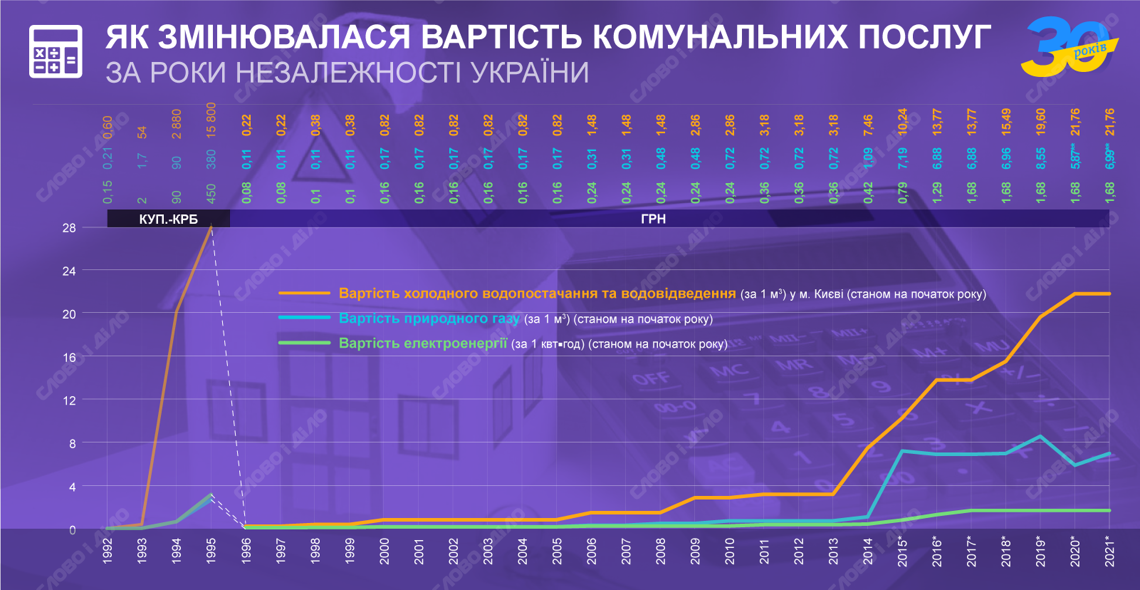
Tariffs in Ukraine
Electricity and water prices are constantly changing and growing in our country, this is the eternal pain of Ukrainians. Despite various social programs, tariffs for a large percentage of the population remain high, compared with average wages. According to statistics, each family on average has a debt for utilities of more than 5 thousand hryvnia. Accordingly, the increase in tariffs may not have any effect, as it will only increase the total debt of citizens.
Let's look at and compare the ratio of tariffs since Ukraine gained independence with the current one, and also make an approximate forecast of price growth for the coming years.
European experts note that at the moment Ukraine has one of the highest prices in Europe for electricity. It is equal to the cost in Poland, Greece, Malta, but the salaries of Ukrainians do not reach this level.
How the tariff is formed
The first and most basic role in the formation of a new tariff is played by the cost of components and resources, which is calculated by an authorized enterprise. Then these figures are transmitted to local governments and then the final tariff is compiled, which will also be affected:
* cost of energy tariffs;
* prices for material and technical resources;
* minimum wage level.
The tariff includes:
* payment for the consumed resource,
· the cost of upgrading equipment,
* remuneration of specialists,
* other operating expenses.
All consumed resources (gas, water, heat, electricity) are interconnected, and the rise in price of one of them leads to an increase in the price of the other.
Statistics of prices and tariffs for the years of independence of Ukraine
The basis of the tariff policy is the system of forming the cost of utilities, and until it changes, you should not wait for any comforting forecasts.
The growth of utility tariffs is a natural process that occurs together with inflation and other planned changes in the economy of the state.
Below is a diagram of how the cost of utilities has changed since Ukraine gained independence to this day:

It can be noticed that the tariffs varied depending on the period. From 1991 to 1996, there were karbovans in Ukraine and the tariffs were penny. However, even after switching to the hryvnia, they increased slightly or remained unchanged, while average salaries grew slightly. In 2006 and 2009, people felt a slight rise in price, but the strongest jump occurred in 2014. After 2018 and 2021, tariffs also began to increase, which caused a wave of protests and discontent.
Forecasts for the coming years
According to the calculations of the Ministry of Economy, the cost of heating and hot water will only increase. In 2021, it will grow by 33%, and then every year it will grow by 5-6%. Similar forecasts are given for water supply tariffs: in 2021 – by 20%, in 2022 - by 11% and further by 5% annually.
However, experienced analysts and experts say that such figures simply cannot be, and all price increases will be systematic, by 20-30% every year. Given this trend, the average salaries of the Ukrainian population should grow by no less than 30% per year (as inflation occurs, prices rise in all spheres of life), which is unlikely. Despite the fact that the consumption of gas, heat, and electricity by people has really decreased over 10-20 years, which is good for the planet and the environment, this does not protect people from poverty in any way, and the country from future economic disasters.
It remains to think about ways to save money and use alternative sources of heat and energy in their homes.
And since in order to finance Ukraine by the International Monetary Fund and to secure these loans, as well as for equal competition in the market of goods in the European Union, the price of energy carriers must be the same and will strive for European prices until it is equal (otherwise products produced in Ukraine will have a cost price lower than in Europe - and it is not profitable for them). Therefore, the price for 1 kW of electricity bedet tends to 25 Euro cents at the current exchange rate on 14.10.21 is 8.75 UAH for 1 kW of Electricity.
The European Union is constantly investing money in Africa and building solar and helio stations there. According to the calculation, taking into account the growth trend of the price. The payback period of solar panels is 6-8 years. Solar collectors are 2-4 Years Old. These are good indicators for investing in your energy independence. True, the EU government encourages citizens more actively by offering them benefits, discounts, interest-free loans (installments) for installing alternative energy in homes.





Leave a Comment